

Sourdough Science. 17 Wonderful Health Benefits and Uses Of Cherries. History of Cherries.
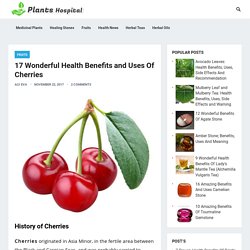
16 Health Benefits of Phytic Acid: The "Anti-Nutrient" The Biology of . . . Sourdough. About 34 years ago, Frank Sugihara recalls, he and Leo Kline, a fellow microbiologist, set out to "solve the mystery of San Francisco sourdough.

" The two scientists were working with baker's yeast in a Bay Area lab run by the U.S. Department of Agriculture, so perhaps it was inevitable they'd wind up studying San Francisco's signature bread. 5 Foods That Can Cause Depression. International Dairy Foods Association. The Evolution of Ice Cream Ice cream's origins are known to reach back as far as the second century B.C., although no specific date of origin nor inventor has been undisputably credited with its discovery.
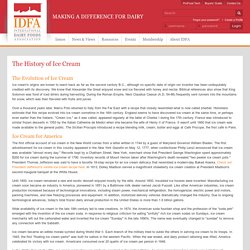
Using Salt as a Food Preservative. Preserving food with salt is an ancient human practice that dates back before written records.
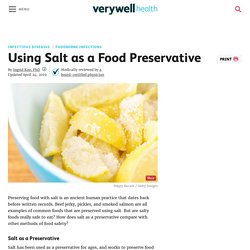
Beef jerky, pickles, and smoked salmon are all examples of common foods that are preserved using salt. But are salty foods really safe to eat? How does salt as a preservative compare with other methods of food safety? Salt as a Preservative Salt has been used as a preservative for ages, and works to preserve food in two ways: Salt dries food. Medieval food with recipes - European food in the Middle Ages - Quatr.us Study Guides. Medieval food: A man ladles porridge from a large pot over a fire.
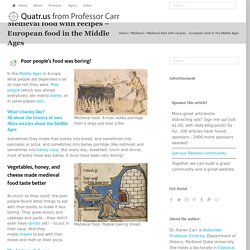
Choice page. The Hidden History of Greco-Roman Vegetarianism – Advocacy for Animals. This week, Advocacy for Animals introduces a new author to our audience.

Nathan Morgan, a 2010 graduate of Montana State University Billings, gave a paper on the topic of vegetarianism in the classical world at a recent animal welfare conference in Minneapolis. Meat. Brain Health and Fish. When is the last time you had fish for dinner?

If you can't remember, it may be more than the passage of time that's to blame. Research suggests that improved memory is just one of many brain-boosting benefits associated with eating more fish. You Are What You Eat You've likely heard that omega-3 fatty acids are good for your health. But one in particular, docosahexaenoic acid, or DHA, goes straight to your head. DHA is an omega-3 fatty acid that is required to keep the brain functioning normally and efficiently. If you think higher levels of DHA in your diet might simply help you remember to put fish on your shopping list, keep in mind that studies link DHA deficiencies to more serious cognitive problems than occasional forgetfulness. This is how smoked salmon is really made. After it's properly dried, we're finally ready to smoke the salmon.
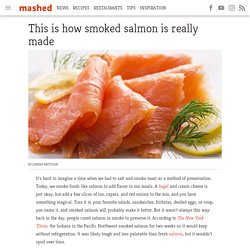
Alder a popular wood for smoking salmon, but you can use any type of hardwood you like. Some companies prefer maple or apple wood because it gives the fish a sweet characteristic. Is nitrite-free meat the next big ‘free from’ opportunity? Sodium nitrite and potassium nitrate – also known as saltpetre – have been used to rapidly cure ham and bacon for decades.
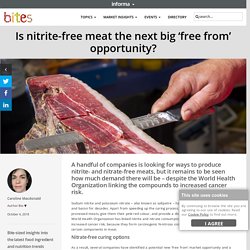
Apart from speeding up the curing process, they extend the shelf life of processed meats, give them their pink-red colour, and provide a distinct tangy flavour. However, the World Health Organization has linked nitrite and nitrate consumption from processed meat to increased cancer risk, because they form carcinogenic N-nitroso compounds when they react with certain components in meat. Nitrate-free curing options As a result, several companies have identified a potential new ‘free from’ market opportunity and a small number of nitrite-free products is available across Europe. The truth about cured meat. Listen to all the hype, and it's easy to believe that nitrates are bad.
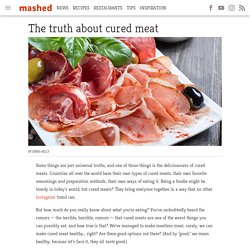
But it's not that straightforward, says the BBC, and around 80 percent of the nitrates we ingest come not from processed meats but from vegetables. And in those cases, they're a good thing. Yes, bacon really is killing us. There was a little cafe I used to go to that did the best bacon sandwiches. They came in a soft and pillowy white bap. The bacon, thick-cut from a local butcher, was midway between crispy and chewy. Ketchup and HP sauce were served in miniature jars with the sandwich, so you could dab on the exact amount you liked. That was all there was to it: just bread and bacon and sauce. The fascinating, untold truth about bacon. As a general rule, anything that tastes awesome probably isn't very good for you, and bacon is sadly no exception. It's full of salt, fat, and nitrites which have been blamed for causing heart disease, among many other unpleasant ailments.
Difference Between Seeds and Grains. Seeds vs Grains A seed is defined as an embryonic plant covered in a seed coat, often containing some food. Difference Between Grain and Seed - DifferenceBetween.com. Grain vs Seed Sometimes, the terms seeds and grains are misused due to confusion of meaning of these two, but both the grain and seed have separate meaning and characteristic features. However, some seeds are grains. The intention of this article to discuss the difference between these two terms. Grain The word grain has two different meanings. Seed The general meaning of seed is “anything that can be sown”. The History Kitchen Blog. Sandwich History, Whats Cooking America. Unpacking the Stacked History of the Sandwich. Almost everybody, everywhere, eats sandwiches. Collectively, by one estimate, Americans wolf down about 45 billion sandwiches a year. Each day, according to a 2014 study, half of all American adults eat at least one sandwich.
Foods dietitians recommend specifically for women. Seafood is basically nutritional magic when it comes to your health. The Business Case for Reducing Food Loss and Waste: Restaurants. Food waste has tremendous economic, social, and environmental consequences, but it is preventable. The untold truth of truffles. 50 best foods in the world. BIO.Availability. Nutrition Dissected.